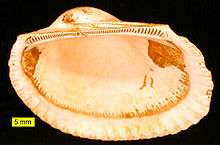Arcida
| Arcida | |
|---|---|
 | |
| Anadara from the Pliocene of Cyprus. | |
| Scientific classification | |
| Kingdom: | Animalia |
| Phylum: | Mollusca |
| Class: | Bivalvia |
| Subclass: | Pteriomorphia |
| Order: | Arcida |
| Families | |
|
11, See text. | |
The Arcoida is an extant order of bivalve molluscs.[1] This order dates back to the lower Ordovician period. They are distinguished from related groups, such as the mussels, by having a straight hinge to the shells, and the adductor muscles being of equal size.[2] The duplivincular ligament, taxodont dentition, and a shell microstructure consisting of the outer crossed lamellar and inner complex crossed lamellar layers are defining characters of this order.[3]
Seven families are currently recognised within the order, including the well-known ark clams or ark shells in the family Arcidae.
Taxonomy of the Arcoida
The order Acoida, as the suborder Arcacea, is included in the order Taxodonta by R.C. Moore, 1952,[4] characterised by simple hinge-line dentition consisting of small, numerous, similar hinge teeth, separate mantle lobes, poorly developed siphons, and filibranch gills.
In 2010, Bieler, Carter & Coan[5] proposed a new classification system for the Bivalvia which combines the taxodont Arcoida with the dysodont Limnoida Mytiloida, Ostreoida and Pteroida as the Pteriomorphia. Subtaxa included in the Arcoida are shown below.
In 2016, the superfamilies of Arcida changed from two to three, with an additional superfamily of fossils only. The new taxonomy is as follows:[1][5]
- Superfamily Arcoidea Lamarck, 1809[6]
- Family Arcidae Lamarck, 1809
- Family Catamarcaiidae Cope, 2000

- Family Cucullaeidae Stewart, 1930
- Family Frejidae Ratter & Cope, 1998

- Family Glycymerididae Dall, 1908 (1847)
- Family Noetiidae Stewart, 1930
- Family Parallelodontidae Dall, 1898
- Superfamily Glyptarcoidea Cope, 1996

- Family Glyptarcidae Cope, 1996

- Family Pucamyidae Sánchez & Benedetto, 2007

- Family Glyptarcidae Cope, 1996
- Superfamily Limopsoidea Dall, 1895[10]
- Family Limopsidae Dall, 1895
- Family Philobryidae F. Bernard, 1897
References
- 1 2 WoRMS. "Arcoida Stoliczka, 1871". World Register of Marine Species. Retrieved 2017-01-15.
- ↑ Barnes, Robert D. (1982). Invertebrate Zoology. Philadelphia, PA: Holt-Saunders International. p. 430. ISBN 0-03-056747-5.
- ↑ Matsumoto, M. (2003). "Phylogenetic analysis of the subclass Pteriomorphia (Bivalvia) from mtDNA COI sequences". Molecular Phylogenetics and Evolution. 27 (3): 429. doi:10.1016/S1055-7903(03)00013-7.
- ↑ R.C, Moore, Pelecypods, Ch 10, Inverrtebrate Fossils, Moore, Lalicker, and Fischer. McGraw-Hill, 1952.
- 1 2 Bieler, R.; Carter, J.G.; Coan, E.V. (2010). "Classification of Bivalve families". In Bouchet, P.; Rocroi, J.P. Nomenclator of Bivalve Families. Malacologia. 52. pp. 113–133. doi:10.4002/040.052.0201.
- ↑ WoRMS. "Arcoidea Lamarck, 1809". World Register of Marine Species. Retrieved 2017-01-15.
- ↑ Lemer, S.; González, V.L.; Bieler, R.; Giribet, G. (2016). "Cementing mussels to oysters in the pteriomorphian tree: a phylogenomic approach". Proceedings of the Royal Society B: Biological Sciences. 283 (20160857). doi:10.1098/rspb.2016.0857.
- ↑ WoRMS. "Glyptarcoidea Cope, 1996". World Register of Marine Species. Retrieved 2017-01-15.
- ↑ Cope, J. C. W. (1996). "Early Ordovician (Arenig) bivalves from the Llangynog inlier, South Wales". Palaeontology. 39 (4): 979–1025, pl. 1–7.
- ↑ WoRMS. "Limopsoidea Dall, 1895". World Register of Marine Species. Retrieved 2017-01-15.
External links
![]()